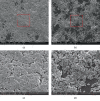Antimicrobial Effect of a Peptide Containing Novel Oral Spray on Streptococcus mutans
- PMID: 32258136
- PMCID: PMC7086434
- DOI: 10.1155/2020/6853652
Antimicrobial Effect of a Peptide Containing Novel Oral Spray on Streptococcus mutans
Abstract
Objective: To investigate the antibacterial effect of a novel antimicrobial peptide containing oral spray GERM CLEAN on Streptococcus mutans (S. mutans) in vitro and further explore the related mechanisms at phenotypic and transcriptional levels.
Methods: The disk diffusion method was used to preliminarily appraise the antimicrobial effect of GERM CLEAN. The minimal inhibitory concentration (MIC) of GREM CLEAN towards S. mutans was determined by the broth dilution method. S. mutans was determined by the broth dilution method.
Results: The diameter (10.18 ± 1.744 mm) of inhibition zones formed by GERM CLEAN preliminarily indicated its inhibitory effect on the major cariogenic bacteria S. mutans was determined by the broth dilution method. S. mutans was determined by the broth dilution method. S. mutans was determined by the broth dilution method. S. mutans was determined by the broth dilution method. gtfB, gtfC, gtfD, and ldh were significantly repressed by treating with GERM CLEAN, and this was consistent with our phenotypic results.
Conclusion: The novel antimicrobial peptide containing oral spray GERM CLEAN has an anti-Streptococcus mutans effect and the inhibitory property may be due to suppression of the virulence factors of S. mutans including adhesive, acidogenicity, EPS, and biofilm formation.Streptococcus mutans effect and the inhibitory property may be due to suppression of the virulence factors of S. mutans including adhesive, acidogenicity, EPS, and biofilm formation.S. mutans was determined by the broth dilution method.
Copyright © 2020 Kaixin Xiong et al.
Conflict of interest statement
The authors declare that there are no conflicts of interest related to this study.
Figures







Similar articles
-
Anticariogenic activities of Libidibia ferrea, gallic acid and ethyl gallate against Streptococcus mutans in biofilm model.J Ethnopharmacol. 2021 Jun 28;274:114059. doi: 10.1016/j.jep.2021.114059. Epub 2021 Mar 29. J Ethnopharmacol. 2021. PMID: 33794333
-
Effects of Antimicrobial Peptide GH12 on the Cariogenic Properties and Composition of a Cariogenic Multispecies Biofilm.Appl Environ Microbiol. 2018 Nov 30;84(24):e01423-18. doi: 10.1128/AEM.01423-18. Print 2018 Dec 15. Appl Environ Microbiol. 2018. PMID: 30341079 Free PMC article.
-
Anticaries activity of GERM CLEAN in Streptococcus mutans and Candida albicans dual-species biofilm.Oral Dis. 2022 Apr;28(3):829-839. doi: 10.1111/odi.13799. Epub 2021 Feb 21. Oral Dis. 2022. PMID: 33583105
-
Utilization of the extract of Cedrus deodara (Roxb. ex D.Don) G. Don against the biofilm formation and the expression of virulence genes of cariogenic bacterium Streptococcus mutans.J Ethnopharmacol. 2020 Jul 15;257:112856. doi: 10.1016/j.jep.2020.112856. Epub 2020 Apr 9. J Ethnopharmacol. 2020. PMID: 32278760
-
The enhancing antibiofilm activity of curcumin on Streptococcus mutans strains from severe early childhood caries.BMC Microbiol. 2020 Sep 16;20(1):286. doi: 10.1186/s12866-020-01975-5. BMC Microbiol. 2020. PMID: 32938379 Free PMC article.
Cited by
-
The Inhibitory Effects of Ficin on Streptococcus mutans Biofilm Formation.Biomed Res Int. 2021 Mar 23;2021:6692328. doi: 10.1155/2021/6692328. eCollection 2021. Biomed Res Int. 2021. PMID: 33860052 Free PMC article.
-
The remineralization effect of GERM CLEAN on early human enamel caries lesions in vitro.Sci Rep. 2023 Mar 13;13(1):4178. doi: 10.1038/s41598-023-31405-1. Sci Rep. 2023. PMID: 36914750 Free PMC article.
-
Antimicrobial peptide temporin derivatives inhibit biofilm formation and virulence factor expression of Streptococcus mutans.Front Microbiol. 2023 Sep 26;14:1267389. doi: 10.3389/fmicb.2023.1267389. eCollection 2023. Front Microbiol. 2023. PMID: 37822738 Free PMC article.
-
Synthesis of silver nanoparticles using gum Arabic: Evaluation of its inhibitory action on Streptococcus mutans causing dental caries and endocarditis.J Infect Public Health. 2021 Mar;14(3):324-330. doi: 10.1016/j.jiph.2020.12.016. Epub 2021 Feb 19. J Infect Public Health. 2021. PMID: 33618277 Free PMC article.
-
Unlocking the potential of trifluoromethyl pyrrole derivatives in chronic wounds management: rapid synthesis, structural insights, and potent antimicrobial activity.J Enzyme Inhib Med Chem. 2025 Dec;40(1):2513406. doi: 10.1080/14756366.2025.2513406. Epub 2025 Jun 11. J Enzyme Inhib Med Chem. 2025. PMID: 40497717 Free PMC article.
References
-
- Islam B., Khan S. N., Khan A. U. Dental caries: from infection to prevention. Medical Science Monitor: International Medical Journal of Experimental and Clinical Research. 2007;13(11):RA196–203. - PubMed
MeSH terms
Substances
LinkOut - more resources
Full Text Sources
Medical

